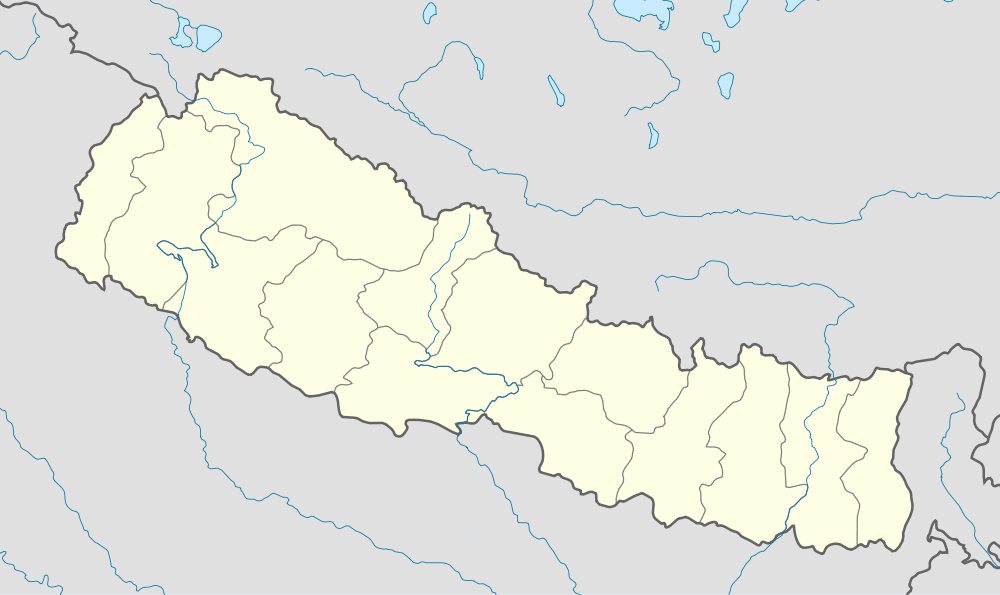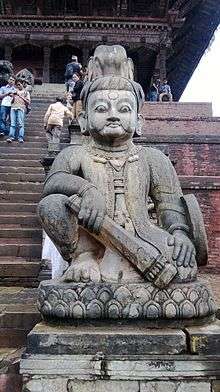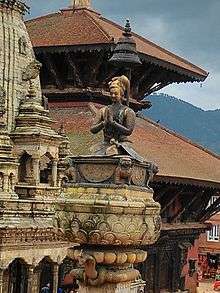Nyatapola
| Nyatapola | |
|---|---|
|
Nyatapola | |
 Nyatapola location in nepal | |
| Name | |
| Other names | Five-storeyed Temple, Taleju |
| Devanagari | न्यातपोल |
| Geography | |
| Coordinates | 27°40′17″N 85°25′43″E / 27.67139°N 85.42861°ECoordinates: 27°40′17″N 85°25′43″E / 27.67139°N 85.42861°E |
| Country | Nepal |
| District | Bhaktapur |
| Locale | Bhaktapur, Taumadhi |
| Culture | |
| Primary deity | Siddhi Laxmi, Goddess Durga |
| Important festivals | Dashain |
| Architecture | |
| Architectural styles | Pagoda |
| History and governance | |
| Creator | Bhupatindra Malla |


Nyatapola Temple is a 5-story pagoda located in Bhaktapur, Nepal. The temple was erected by Nepali King Bhupatindra Malla during a 7-month period from late 1701 into 1702. It is the temple of Siddha Laxmi, the Hindu goddess of prosperity.[1]
How it was built
It was built only in 7 months from the time it started.King Bhupatindra Malla`s account book state that it was built only in 7 month by the help of other neighbours like Challing,Jitpur ,Bagshowari,Shakhu,Jhaukhel,Changu,Gokarna,Paunati,e.t.c.His kingdom had bad relation to neighbour to west like Kritipur,Kantipur.So,to show them that he is also powerful,he built it.It was built in time,when Taj mahal was in construction .He also stated that he had build 7 brick factory for bricks and all raw materials were brought in advance.The biggest challenge was to bring a huge stone from challing which is almost 9K.M from temple.At last he call for the feast to all citizen and neighbour kings to show.In that feast about 23000 people were there; which was the 4times of citizen of Bhaktapur .It was written in a thick book which was discover by Dr.Madan Lal Baidaya.
City History
In the eighteenth century Bhaktapur was known country-wide for its production of quality pottery pieces and beautiful art works, which included sculptures completed in both wood and stone. Today this reputation Bhaktapur continues and is sustained by the tourist industry, which flourishes in this area. The city gives you a glimpse of what life was like centuries ago having changed very little since it was first formed.
Durbar Square can be found in the center of Bhaktapur and like Kathmandu contains many beautiful temples where the Nepalese people can go and pay homage to one of the many Hindu gods. At one point the square was crowded with temples and statues but with the 1934 earthquake many of these ancient buildings were destroyed and to this day have yet to be built again. In comparison to the city of Patan, the Bhaktapur Durbar Square is bigger and more neatly laid out but with many empty spaces where temples once stood.
Construction
Bhaktapur is one of the three cities found in the Kathmandu Valley in Nepal not far from the capital city of Kathmandu. The name Bhaktapur means "City of devotees". Today this ancient, medieval city, from the fifteenth century, is part of the UNESCO World Heritage site, which records buildings that are of cultural and natural value universally.
The Nyatapola Temple
One of the temples that are still in existence today is the Nyatapola Temple, which was built in 1702 A.D. under the rule of King Bhupatindra Malla. This beautifully sculptured building is considered one of the tallest pagodas in the country and is a lovely example of the immense workmanship that went into buildings of this type. This five-storey temple with a five-tier roof that stands just over thirty meters high can be reached by walking up a flight of steps that leads to the top of the platform. As you walk up these terraces you will notice that there are statues on either side of you, on every step.
Religious figures and gods
The Nyatapola temple was built and dedicated to the goddess Siddhi Lakshmi or Siddhi Laxmi, providing the Nepalese with a place to worship her. Like so many of the other temples the image of the goddess that is contained within the temple of Nyatapola is viewed strictly by the priests only. Dominating Taumadhi Square is the Nyatapola Temple, a five-tiered pagoda dedicated to the Hindu goddess Siddhi Lakshmi. She is the wrathful manifestation of the Goddess Durga. The temple rests on a base of five levels with four Ganesh shrines in each of the corners. Nyatapola means "five-story temple" in the Newari language. Legend tells of the days when the angry god Bhairab was causing havoc in society (1702 AD). Bhairab’s temple stood in Taumadhi Square. To counteract his destructive behavior the king decided to build a more powerful temple right in front of the Bhairab Temple. To make the brick and wood temple strong and powerful, King Bhupatendra Malla ordered guardians be placed in pairs on each level of the base leading up to the Nyatapola Temple. On the first level is a pair of likenesses of Rajput warriors Jaimal and Phatta, famous 16th century defenders of the Chittor fort. Next, two elephants followed by two lions, two griffins and finally "Baghini" and "Singhini", the tiger and lion goddesses. After subduing Bhairab, peace prevailed in the city. The Temple is the tallest temple in the Kathmandu Valley and stands 30 m high. It was so well designed that it withstood a powerful 8.3 earthquake in 1934. The image of Siddhi Lakshmi is locked within the temple and only the priests are allowed to enter to worship her.
The Legend
Legend tells of the days when the angry god Bhairab was causing havoc in society (1702 AD). Bhairab’s temple stood in Taumadhi Square. To counteract his destructive behavior the king decided to call goddess parvati, then Parvati took the form of Siddhi laxmi and then carried Bhairav in her hand and built a more powerful temple on the honor of Siddhi Laxmi (Parvati) right in front of the Bhairab Temple. To make the brick and wood temple strong and powerful, King Bhupatendra Malla ordered guardians be placed in pairs on each level of the base leading up to the Nyatapola Temple. On the first level is a pair of likenesses of Bhaktapur’s strongest man, Jaya mal Pata, a famous wrestler. Next, two elephants followed by two lions, two griffons and finally "Baghini" and "Singhini", the tiger and lion goddesses. After subduing Bhairab, peace prevailed in the city. The Temple is the tallest temple in the Kathmandu Valley and stands 30 m high. It was so well designed that it withstood a powerful 8.3 earthquake in 1934. The image of Siddhi Lakshmi is locked within the temple and only the priests are allowed to enter to worship her. The five-storeyed temple, locally known as Nyatapola, is an impressive and famous temple of Nepal, standing in the northern side of Taumadhi square in Bhaktapur. This is the only temple that is named after the dimension of architecture rather than from the name of the deity residing inside. The temple was erected within a short period of less than five months by King Bhupatindra Malla in 1701/1702 A.D. In the present context of work-schedule, planning and programming, it is very difficult to believe that the temple was erected within that short period of time. But it was the fact. The incidents are recorded day by day.
If we look at the calendar of construction it gives us an interesting picture of the spirit of the people and speed of the work accomplished within such a short period of time. The speed of work done in religious faith can never be accomplished in modern-day society run by materialistic considerations.
2015 Earthquake
The Nyatapola survived the 2015 earthquake in spite of having the tallest shikhara in the valley. Many other temples were also damaged in the 2015 earthquake.[2][3] It had also survived the 1934 Nepal–Bihar earthquake that had damaged many other temples.[4]
Historical Sources and records

These interesting details were found while going into the Siddhagni Kotyahuti Devala Pratistha manuscript.[5] From the start of digging the foundation to the completion of roofing, it took merely eighty-eight days. The excavation work for foundation lasted for seven days. Then was commenced construction of six plinths. That was accomplished in thirty-one days, and immediately after that started the erection of the superstructure. That was also completed within thirty-four days, after which roofing work was started from top to the lowest roof. In sixteen days all the five roofs were completed paving them with mini-tiles (jhingati). Then they had to wait for an auspicious day for erecting the icons in the sanctum sanctorum and fix the pinnacle on the top of the temple. For this, they did wait for 38 days. In the meantime the auspicious fire-sacrifice (Siddhagni Kotyahuti Yajna) was going on.
Presented here are six pages (three folios) of the facsimile copies of the manuscript which recorded major events from beginning to the end, as summary of records in advance, incorporated in the manuscript containing 264 folios. There are fifty major records in the summary six-page facsimile.
The manuscript is preserved in the National Archives of Nepal. It is readily available for the readers in micro-film as well, which can be read in the office or could be purchased in photocopy paying certain rupees per page.
The name of the manuscript is recorded as Siddhagni Kotyahuti Devala Pratistha. The name itself kept the enthusiasts on the subject of ancient architecture behind the curtain from knowing it. The accession number of the manuscript is cat. I. 1115 NGMPP micro number A 249/5. The manuscript is written in the Newar script in yellow Nepalese paper coated with harital (orpiment). The size is 17.2 x 46.5 cm. Each page has nine lines. The manuscript has 264 folios, and the rest are missing Dr Janak Lal Vaidya thinks. Some folios are ink-stained and some are damaged by rats. All the rest of the folios are in good condition. The calligraphy is magnificent.
Out of these six facsimile pages, Dr. Janak Lal Vaidya has published three folios (1, 2 and 4) without any transliteration and translation in Abhilekh No.8 published by the National Archives of Nepal. It is, however, necessary at least to give a full picture of the detailed records in those six important pages.
There are still interesting information contained in the following folios of the manuscript which were published by Dr. Janak Lal Vaidya in his articles published in Abhilekh, No. 8 and No. 14 and Kheluita No. 11 in English, Nepali and Newar respectively.
Translation of facsimile copy
Salute! To the god Ganesa. This is the work index of the construction of Nyatapola Temple (Five-storeyed Temple) and the performance of Siddhagni Kotyahuti fire sacrifice (done) by Bhupatindra Malla. (The king of Bhaktapur) [Then starts the entry]
1. On Thursday, the third day of clear fortnight in the month of karttika of Nepal Samvat 822, the people (the ones who fell the tree) were sent to fell the trees in the jungle.
2. (After 25 days) On Monday, the twelfth of clear fortnight in the month of Marga of Nepal Sam. vat 822, this day the wood work (carpentry) started.
3. (After 31 days) On Thursdsy, the twelfth/thirteen of dark fortnight in the month of Pausa of Nepal Samvat 822, the excavation work for foundation started.
4. (After 7 days) On Thursday, the fifth of clear fortnight in the month of Magha of Nepal Sam. vat 822, the foundation stone was laid (construction of the foundation started).
5. (After 31 days) On Sunday, the sixth of dark fortnight in the month of Phaguna of Nepal Samvat 822, this day the main entrance (to the sanctumsanctorum) was erected.
6. (After 5 days) On Friday, the eleventh of dark fortnight in the month of Phalguna of Nepal Samvat 822, this day the amoral spinal beam (ninala). was laid.
7. (After 11 days) On Thursday, the seventh of bright fortnight in the month of Caitra of Nepal Sam. vat 822, the windows (were) erected in lowest (first) storey.
8. (After 11 days) On Saturday, the third of dark fortnight in the month of Caitra of Nepal Sam. vat 822, the windows (were) erected in second storey.
9. (After three days) On Tuesday, the seventh of dark fortnight in the month of Caitra of Nepal Samvat 822, the windows were erected in the third storey.
10. (After four days) On Saturday, the eleventh of dark fortnight of Caitra of Nepal Samvat 822, the windows (were) erected in the fourth storey.
11. (After two days) On Monday the thirteenth of dark fortnight in the month of Caitra of Nepal Samvat 822, the windows (were) erected in the last (fifth) storey.
12. (After 3 days) On Thursday, the fifteenth of dark fortnight (no moon day) in the month of Caitra of Nepal Samvat 822, the pithapuja performed (to appease the pithagana) in order to erect the top of the temple.
13. (After 14 days) On Thursday, the third of clear fortnight in the month of Vaisakha of Nepal Samvat 822, the top of the temple offered (erected).
14. (After 7 days) On Thursday, the seventh of clear fortnight in the month of Vaisakha of Nepal Sawvat 822, the topmost roof was covered with minitiles.
15. (After 2 days) On Saturday, the ninth of clear fortnight in the month of Vaisakha of Nepal Samvat 822, the roofing is completed on the fourth storey.
16. (After 2 days) On Monday, the eleventh of clear fortnight in the month of Vaisakha of Nepal Samvat 822, the roofing is completed on the third (middle) roof.
17. (After 4 days) On Friday, the first of dark fortnight in the month Vaisakha of Nepal Samvat 822, the roofing is constructed on the second roof.
18. (Next day) On Saturday, the second of dark fortnight in the month Vaisakha of Nepal Sam vat 822, the ceremony of offering of areca nuts is performed.
19. (Next day) On Sunday, the third of dark fortnight in the month of Vaisakha of Nepal Samvat 822, the puja (worship) was sent to Pithas, Jawodaka, Shivasakti and Kalasa.
20. (Next day) On Monday, the fourth of dark fortnight in the month of Vaisakha of Nepal Samvat 822, the worship and propitious ritual is performed in Pithas (Pitharchana).
21. (Next day) On Tuesday, the fifth of dark fortnight in the month of Vaisakha of Nepal Samvat 822, the act of purascarana is performed.
22. (After 2 days) On Thursday, the seventh of dark fortnight in the month of Vaisakha of Nepal Samvat 822, the arrangement for mandapa is done.
23. (Next day) On Friday, the eighth of dark fortnight in the month of Vaisakha of Nepal Samvat 822, the roofing is done on the fifth (top most) roof. Or the roofing work is completed in the temple.
24. (Next day) On Saturday, the ninth of dark fortnight in the month of Vaisakha of Nepal Samvat 822, the excavation work is done for making fire altar (kunda).
25. (After 2 days) On Monday, the eleventh of dark fortnight in the month of Vaisakha of Nepal Sara. vat 822, the foundation stone is laid to erect the fire altar.
26. (After 2 days) On Wednesday, the thirteenth of dark fortnight in the month of Vaisakha of Nepal Samvat 822, the tympanum is offered (fixed) at the main entrance.
27. (After 3 days) On Saturday, the first of clear fortnight in the month Jyestha of Nepal Samvat 822, Ankurarcana ceremony is performed.
28. (After 5 days) On Thursday, the sixth of dark fortnight in the month of Jyestha of Nepal Samvat 822, different (many-fold) rituals-consecration, propitious, worships, offerings, are performed like Punyahawachala, Rritwijavarna, Mandapa puja, sun-worship, door worship, Guru-worship, and offering of roof hanging (pata) and so on.
29. (Next day) On Friday, the seventh of clear fortnight in the month of Jyestha of Nepal Samvat 822, different acts are done...
Gallery
 Festival
Festival- Wooden construction details
- Wooden construction
 Nyatpola & Bhairav Temples
Nyatpola & Bhairav Temples.jpg) Bhairav Temple from Nyatpola
Bhairav Temple from Nyatpola.jpg) Taumadhi Square
Taumadhi Square- Wooden wheels of a disassembled festival cart for Bisket Jatra
- Bhojanalaya overlooking the temples






References
- ↑ "Work index of Nyatapola temple". Goliath Business News. Retrieved 9 September 2009.
- ↑ Just returned from Bhaktapur, Nepal: Lesson learned the hardest way, ETN NEPAL, APR 29, 2015
- ↑ Man, baby rescued from rubble in Nepal, CNN, Apr 29, 2015, Chief Medical Correspondent Dr. Sanjay Gupta reports from Nepal, at 1:48
- ↑ Nepal earthquake: Centuries of architectural heritage gone in 80 seconds, PTI, Mid-Day, 01-May-2015
- ↑ Research Note Work Index Of Nyatapola Temple, Contributions to Nepalese Studies, Vol. 32, NO.2 (July 2005), 267-275.